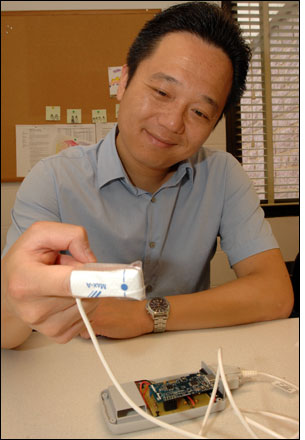At Barnes-Jewish Hospital, located in St. Louis, Mo., researchers are testing a ZigBee-based RFID sensor system that tracks patients’ vital signs. The solution provides hospital employees with data regarding the vital signs of patients moving about the facility, using a sensor attached to the finger, and a transmitter worn around the neck.
The system is the result of years of research and collaboration between computer scientists at Washington University in St. Louis, the hospital’s IT department, and medical doctors, according to Chenyang Lu, a computer science professor and the project’s leader. Lu partnered with physician Tom Bailey to develop a distributed sensor network that would enable hospital staff members to monitor the vital signs of patients who are not in the intensive care unit (ICU), but who require medical attention, including the regular tracking of their vital signs. The solution, the prototype of which is currently being tested, includes sensors known as pulse oximeters that measure a patient’s heart rate and blood oxygenation level. The sensors are wired to what researchers call a telemetry pouch—a microcomputer and an RFID tag that transmits data to relay devices plugged into wall power outlets. Those devices form a ZigBee-based mesh network, transmitting information to each other, and ultimately to a gateway consisting of a laptop cabled to the hospital’s back-end system, where the software—created by Washington University researchers—resides.
The system’s goal is to provide hospitals with real-time data about patients’ health, in what could be called a virtual ICU, allowing patients to move around the hospital while still being monitored. ICU patients are typically confined to their beds, with sensor data managed via wired connections, while the nursing staff closely attends to the patients 24 hours a day. Some are well enough to leave the ICU and begin moving about, but still need to be monitored closely in the event that their condition degenerates, thereby necessitating a return to the ICU. It is this population that researchers are targeting with the wireless technology. The nurses in these “step-down” ICU departments (for those who require monitoring but are well enough to leave the intensive-care area) are often overloaded with tasks, and thus can not monitor patients’ vital signs as frequently as an automated system could.
The wireless system has been through two phases of testing. Initially, from 2009 to 2010, the research team tested the hardware at one step-down cardiac-care unit at Barnes-Jewish Hospital. The goal was to determine whether patients’ vital signs were being measured by the sensor nodes, as well as whether that data was being transmitted as programmed to the relays, and then forwarded to a gateway and the back-end system.
The sensors measure vital signs at preprogrammed rates—for example, every five minutes—and that information is received by the telemetry pouch, which contains a microprocessor, a Texas Instruments (Chipcon) CC2420 ZigBee-compliant transceiver chip and antenna, and a 9-volt battery. The pouch transmits a unique ID number (linked to the particular patient wearing the device) that is sent with the vital-sign data via 2.4 GHz transmissions. All hardware was built by researchers using off-the-shelf components.During the first phase of the trial, reader relay devices were plugged into a power outlet at 18 locations within the step-down cardiac-care unit—mostly in patient rooms, with a few located in hallways. Each relay transmitted its data to the nearest neighboring relay device, which then forwarded that information to other nearby relays until the data reached the gateway. The software collected this sensor data for up to three days, or until the time of a patient’s discharge. The nursing staff recorded the times at which the system was not properly monitoring a patient, with a total of 20 such events recorded for a group of 41 participants, but the bulk of these occurrences were related to improper use of the sensors—such as not wearing the sensor snugly against the finger. During that time, there were three major events in which patients required medical assistance; in each case, the researchers found, the sensor nodes recorded the change in vital statistics, and could have alerted the staff had the system been in place.
The second phase, which began one year ago and is slated to continue until summer 2012, consists of two tiers that include the alerting system (though only in real time for the second tier). During the first tier, the group has been studying the collection of data after it is received by back-end software; it is now developing algorithms to analyze the results of that information, and to make predictions regarding whether a patient requires assistance or needs to be moved back to the ICU.
During Tier Two, which recently commenced, the software is being utilized to collect information in real time, and to respond to that data by placing a call to a staff member’s cell phone in the event that vital signs change excessively.
After the first phase of testing, Lu says, researchers found that sensor reliability was a greater problem than the mesh network’s reliability. Most sensor problems, however, were the result of patients improperly wearing the devices; better patient education, he notes, + increased sensor reading reliability.
After all phases of the pilot are completed, the solution could be used in a variety of ways, such as providing sensor data that could track not only a patient’s heart rate and blood-oxygen levels, but also other vital signs, such as changes in the body resulting from sleep apnea or diabetes. “When we reach a point where the devices are robustly working in such a way that they are proven to reduce fatality rates,” Lu says, the system can be marketed commercially. “We have a very nice interdisciplinary team working on this technology,” he adds, noting that this will ultimately help Lu and his group to develop a system that meets the needs of both patients and nurses, and that operates properly.



